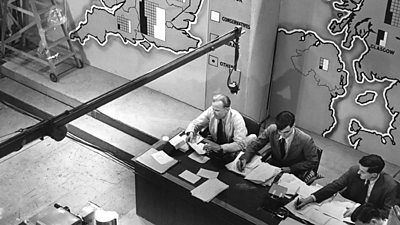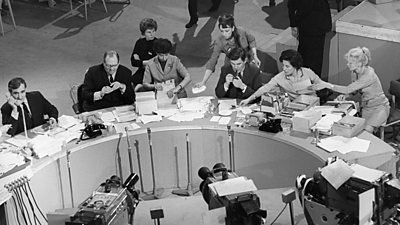Image: Election ’64. By the mid-1960s, television was a fast paced environment, very different from the old radio days
Speed was less of a concern in the days when a ΒιΆΉΤΌΕΔ radio announcer would come to the microphone between programmes to read the latest election results. The advent of the ΒιΆΉΤΌΕΔβs own election results programmes from 1950, however, necessitated a different approach as audiences tuned-in for up-to-date information. Yet, for some considerable time attitudes within the ΒιΆΉΤΌΕΔ lagged behind those if its listeners and viewers.
When preparing for the first election programme, Grace Wyndham Goldie tried to get a direct telephone line installed between ΒιΆΉΤΌΕΔ News, where elections results were received, and the television studio in Alexander Palace. She was refused. Her solution was to make use of a wireless βfieldβ telephone with which an assistant, on a nearby phone line to News, could call in the results to the studio.

Five years later, and three elections on, the television results programme from Lime Grove still had to wait for the results to be phoned through from the News department in Egton House (next door to Broadcasting House). It was not until 1959 that tele-printers was installed in Studio G to carry the Election Results Service.
On the radio, similar problems were experienced. With preparations in an advanced state for the 1955 election night programme, ΒιΆΉΤΌΕΔ News Division, who had a monopoly on the incoming results, refused access. When Stephen Bonarjee, who was in charge of the election programme, asked for a feed from the News tele-printers he was told that it was quite impossible. Only fully trained journalists (i.e. News staff) it was reasoned, could be trusted not to make a mistake.

Following an intervention by the Director-General, Ian Jacob, it was decided that while it was too late provide a direct service, it would be possible for results to be delivered, by hand, the 50 metres between News Division and the election studio. Bonarjee recalled the βKeystone Copsβ scene on election night as βrelays of messengers panted through an underground passage between Egton House and Broadcasting House β¦ to enable us to get on with the job weβd been instructed to do.
Only by overcoming such obstacles as these in its television and radio coverage was the ΒιΆΉΤΌΕΔ able, by 1959, to fully grasp the potential that Grace Wyndham Goldie had envisaged for General Elections nearly a decade earlier.
Politicians and Broadcasting
Broadcasting presents politicians with both an opportunity and a challenge. It is a mechanism for career development and speaking on the national stage. At the same time, for those not adept at this form of communication it can break, just as easily as make, reputations.
As the Editor of Panorama and Controller of ΒιΆΉΤΌΕΔ 1, Paul Fox encountered and assessed the broadcasting credentials of successive Prime Ministers in the 1960s.
As the art of political interviewing developed so the television studio increasingly became a battleground between journalists and politicians. The ΒιΆΉΤΌΕΔβs head of Current Affairs, John Grist had to manage the fall-out from some bruising encounters.
The former ΒιΆΉΤΌΕΔ Secretary William Whitelaw got to see, at close quarters, how successive Conservative Prime Ministers dealt with the ΒιΆΉΤΌΕΔ and managed the pressure of broadcasting.
Harold Wilsonβs turbulent relationship with the ΒιΆΉΤΌΕΔ was indicative of the growing political necessity, in the 1950s and 1960s, of engaging with broadcasters. On the subject of how best to get your message across to the public, Wilson had a clear sense of the approach he should take.
Love it or loathe it, this was an era in which political programming came of age, becoming a cornerstone of News and Current Affairs output. As such, politicians found they had to adapt, whatever their private thoughts, to the increasingly demanding requirements of broadcasting.
Man versus Machine
At 10.18pm on the evening of Thursday 31 March 1966, Polling Day, the ΒιΆΉΤΌΕΔ's statistical expert David Butler interrupted the election night programme. 'That is fundamentally a mistake... our machines have got a little too clever for themselves,' he interjected when the ΒιΆΉΤΌΕΔ computer predicted a Labour majority of 80 seats. It was 'much nearer the 120 / 130 area,' he claimed.
In the end, Labour finished the 1966 General Election with a majority of 96. The competition between expert election analysis and the capacity of computers to process complex data had taken a decisive step forward.
This was not the first time the ΒιΆΉΤΌΕΔ had deployed the power of computing in its election coverage. In 1955, as Michael Peacock noted of the television results, 'a team of slide-rule experts aided by a Logabox adding machine provided a perfectly adequate services'. Radio, meanwhile, had already embarked on a major computer project in preparation for the 1955 election.
Under the supervision of Professor Maurice Kendall of the London School of Economics, it was the first time a computer was used in this capacity in the United Kingdom. In the early hours of 27 May it forecast a Conservative majority of 87, against the eventual figure of 58. For Stephen Bonarjee, who had been in charge of radio election coverage that night, this was a result radio could feel 'quite pleased with'.

By 1959, a great deal of preparation and effort had gone into the acquisition and design of a computer for television results. Preparatory work on the 'National Elliott 402F' computer had begun in November 1958. A week before the 8 October 1959 General Election it was assembled at the ΒιΆΉΤΌΕΔ studios at Lime Grove and on the Tuesday of election week, it was moved into Studio G.
It was also renamed 'Ella', 'partly to avoid having to refer to the manufacturer by name in the programme and partly to add to its human appeal'. At a cost of around Β£1,000 it was considered that 'Ella repaid in full al the work involved, and did everything that was asked of her'. As all subsequent elections would demonstrate, the age of the 'computer-driven' election had arrived.
The battle between man and machine continued to feature regularly in election night programmes, as was the case in 1979.

